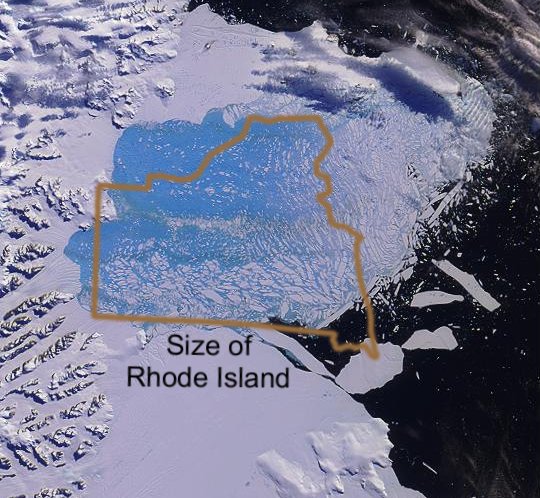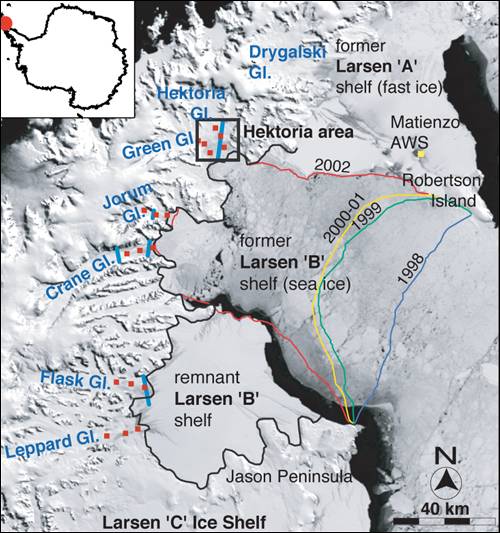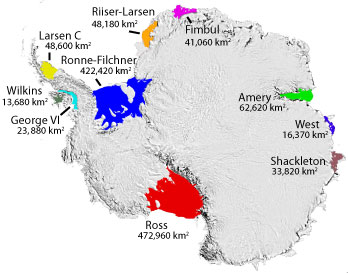Ice shelves
Enlarge text Shrink text- Work cat.: Engels, Jennifer L. New evidence for ice shelf flow across the Alaska and Beaufort margins, Arctic Ocean, 2004.
- McGraw-Hill dictionary of earth science, 2003:p. 188 (ice shelf: a thick sheet of ice with a fairly level or undulating surface, formed along a polar coast and in shallow bays and inlets, fastened to the shore along one side but mostly afloat and nourished by annual accumulation of snow and by the seaward extension of land glaciers)
- Dictionary of natural resource management, 1996:p. 168 (ice shelf: a floating tabular mass of ice at the margin of and attached to an ice sheet)
- NASA Earth observatory Web site, Sept. 15, 2009:glossary (ice shelf: a thick mass of ice extending from a polar shore; the seaward edge is afloat and sometimes extends hundreds of miles into the sea)
- The American Museum of Natural History Web site, Sept. 15, 2009:glossary (ice shelf: thick glacier ice that extends from glaciers on land and floats on the sea; often called an ice tongue when it extends from the mouth of an outlet glacier)
- Wikipedia, Set. 15, 2009(An ice shelf is a thick, floating platform of ice that forms where a glacier or ice sheet flows down to a coastline and onto the ocean surface.)
- WordNet Web site, Sept. 15, 2009(shelf ice, ice shelf: ice that is attached to land but projects out to sea)
- Virtual Antarctica Web site, Sept. 15, 2009:(ice shelf: a floating ice sheet of considerable thickness showing 2-50 meters or more above sea level, attached to the coast)
- British Antarctic survey Web site, Sept. 15, 2009:glossary of Antarctic terms (ice shelf - where ice is flowing off the main Antarctic plateau and is floating on the sea while still joined to the plateau)
- Center for remote sensing of ice sheets Web site, Sept. 15, 2009:vocabulary sheet (ice shelf: a slab of glacial ice floating on the sea, but still attached to, and fed by land-derived ice)
An ice shelf is a large platform of glacial ice floating on the ocean, fed by one or multiple tributary glaciers. Ice shelves form along coastlines where the ice thickness is insufficient to displace the more dense surrounding ocean water. The boundary between the ice shelf (floating) and grounded ice (resting on bedrock or sediment) is referred to as the grounding line; the boundary between the ice shelf and the open ocean (often covered by sea ice) is the ice front or calving front. Ice shelves are found in Antarctica and the Arctic (Greenland, Northern Canada, and the Russian Arctic), and can range in thickness from about 100–1,000 m (330–3,280 ft). The world's largest ice shelves are the Ross Ice Shelf and the Filchner-Ronne Ice Shelf in Antarctica. The movement of ice shelves is principally driven by gravity-induced pressure from the grounded ice. That flow continually moves ice from the grounding line to the seaward front of the shelf. Typically, a shelf front will extend forward for years or decades between major calving events (calving is the sudden release and breaking away of a mass of ice from a glacier, iceberg, ice front, ice shelf, or crevasse). Snow accumulation on the upper surface and melting from the lower surface are also important to the mass balance of an ice shelf. Ice may also accrete onto the underside of the shelf. The effects of climate change are visible in the changes to the cryosphere, such as reduction in sea ice and ice sheets, and disruption of ice shelves. In the last several decades, glaciologists have observed consistent decreases in ice shelf extent through melt, calving, and complete disintegration of some shelves. Well studied examples include disruptions of the Thwaites Ice Shelf, Larsen Ice Shelf, Filchner–Ronne Ice Shelf (all three in the Antarctic) and the disruption of the Ellesmere Ice Shelf in the Arctic.
Read more on Wikipedia >
 Topic
Topic











